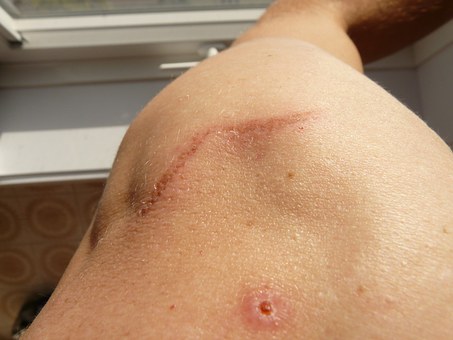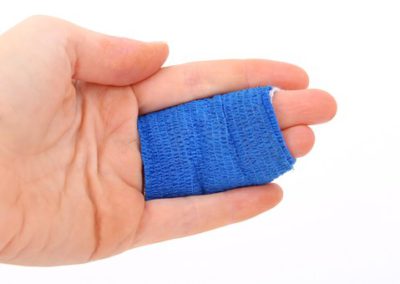
YOUR SKIN CHALLENGE: SCARS AND SCAR REMOVAL
Scarring face is a natural part of the body’s healing process. A scar forms from excess amounts of collagen in the wound as the body attempts a repair. Many scars do eventually fade, but generally, the larger the wound, the longer it takes to heal and the greater the chance of a visible scar being left behind. Scars left on visible parts of the body can cause one distress.
Causes of scarring
Scars are areas of fibrous tissue (fibrosis) that replace normal skin after injury. A scar results from the biological process of wound repair in the skin and other tissues of the body.
Tissue damage can occur for a number of reasons, including:
• accidental injuries – such as cuts from falling off a bicycle
• deliberate harm from a weapon or from self-harm
• cuts made during surgery – such as a Caesarean section birth
• bites and scratches from animals or people
• burns and scalds from hot objects or liquids
• body piercings – such as ear or nose piercings
• injections – such as vaccination against tuberculosis (BCG vaccination)
• tattoos
Scarring face can also be a side effect or a complication of other conditions. For example, if you have a condition that causes a rash, such as chickenpox or acne, you may be left with face scars where the rash was (this is more likely to happen if you scratch or pick at the affected areas).
It is thought that keloid scarring and hypertrophic scarring may run in families. This means you have an increased risk of developing keloid scarring or hypertrophic scarring if a member of your family has previously had these types of scars.
How to Minimize a Scar
When it comes to any injury or surgery scar tissue forms over your wounded skin. This is our body’s amazing way of healing itself and we do sometimes take it for granted. It is only in a time of surgery or when you experience health issues that you run into complications with wound healing or scarring that can affect your welfare and your self-confidence. It is always great to keep yourself informed about wounds, scars and the healing process. Scarring caused by a dreadful injury can stance as a reminder of unpleasant and unwanted memories. Reducing the appearance of scars plays a significant role for surgeons who are in the field of plastic and reconstructive surgery as well as the burns unit. Fortunately, there are many ways you can help support your body’s healing abilities and decrease the presence of scars. We offer a few remedies you can use to help reduce and minimize scarring.
How to Minimize a Scar
Extreme scarring can have many consequences on your skin and body. It can cause tenderness, stiffness, itching, sensitivity, and unwanted appearances and let’s not forget the pain. Proper scar management is essential if you want better results it’s better to start once it’s healed. You may not be able to completely remove your scar, but you can help minimize the amount of scar tissue that’s still present.
Moisturise Your Scar
Regularly applying tissue oil and gently massaging can help you minimize the length, height and thickness of a scar. Keeping it moist and hydrated can also help prevent it from itching as much. Regular massages also help maintain flexibility and movement of the scar around joints or essential tissues.
Common Scar Treatments You Can Use
There are many different scar treatment brands and products and measures you can take that will vary depending on the type of injury or surgery you have. Before you try any of the below treatments, be sure to discuss them with your doctor.
- Always keep your wound or scar clean
- Regularly massage your scar, this is to help decrease sensitivity
- Use a silicone gel to aid with smoothing out the scar and reducing the tightness of the scar tissue
- Firm the scar area with a bandage to help level and smooth the scar tissue
- Appropriate exercises to avoid stiffness and to keep your muscles and certain structures moving
- Cover your wound when out in the sun as it can discolour the scar and possibly slow down its healing process
- Ask your doctor to recommend scar tissue healing ointments for your specific scar
Some scars take longer than others to heal depending on the location of your wound. The one thing about scar tissue is that when treated early – they don’t have to be permanent or as visible. With sustaining a deep scar it can come with emotional and physical pain – Learning how to deal with a healed wound and scar tissue can help you reduce the pain and improve your functionality.

Treatment
At Dr Bhabha Aesthetics we offer a variety of treatments for scarring face including scar removal laser. After a consultation with one of our doctors, the appropriate treatment will be recommended and discussed with you in detail. Some of the treatments we offer for scarring are:
Laser Resurfacing can be performed as a once–off procedure for a more dramatic result or as a series of smaller, individual treatments with less down time. Your healing time will depend upon the size of the treated area, and the depth of the resurfacing. You may experience Erythema (redness), which may last several weeks. Healing time varies among individuals.
Therapy involves injecting tiny amounts of Carbon dioxide (CO2) beneath the skin to break down fatty deposits and stimulate collagen production. After a treatment the gas is totally reabsorbed within 5 minutes and the treated area will raise, turn slightly red as oxygen perfused into the area which undergoes an inflammatory response which stimulates collagen production. Find out more >>
The Dermapen is an automated-micro needling therapy system that vertically pierces the skin to naturally stimulate collagen and elastin with minimal epidermal damage. The procedure is normally completed within 20 minutes for the entire face and neck and up to 60 minutes for the body depending on the size of the problem area. There is minimal downtime after this treatment as you may experience facial redness for 12-48 hours after the procedure. Most people are able to return to normal daily activities immediately after the treatment. Find out more >>>
